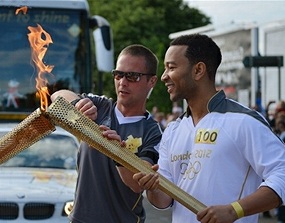 It takes place once every two years, around the time it usually takes for me to get a pay stub — emphasis on stub — for writing one of these articles: the Olympics. The event comes as a reminder when people all of a sudden start getting into fistfights on the street over badminton medal hopefuls.
It takes place once every two years, around the time it usually takes for me to get a pay stub — emphasis on stub — for writing one of these articles: the Olympics. The event comes as a reminder when people all of a sudden start getting into fistfights on the street over badminton medal hopefuls.
For a quick review, the Summer Olympics sports are characterized by those events that were largely conceived in an era when dressing like Mr. Peanut was popular. The sports of the Winter Games were, by and large, borne out of inebriated bets: Why any sober individual would compete in a sport called skeleton is beyond the scope of my imagination. One would think finishing alive would be the priority, with the medals being fussed over once a chiropractor has examined the wreckage.
A discussion on the Olympics themselves is best left to a later date. (Check back in a month.) What concerns this writer is the continuing of a tradition that is rooted in antiquity. No, not the outbreak of plague in the athletes’ village, but the biannual tradition of a torch relay to mark the beginning of the Games.
The Olympic Flame is the symbol of the event. In ancient Greece, it was kept burning throughout the duration of the event and even sometimes afterwards, as evidenced by the members of the 1972 U.S. basketball team. There have been many notable memories surrounding the Olympic torch, some good and, of course leave to me to point them out, the not so good.
A lot of the great memories surrounding the flame itself revolve around the final step, when the flame is used to light the cauldron, surprisingly without the aid of an oven mitt. Rafer Johnson at the Coliseum in 1984. Muhammad Ali in Atlanta in 1996. Cathy Freeman’s dash before the 2000 Olympics. These were moments that not only helped to define those particular Games but stand out in Olympics lore.
The torch itself has traveled around the world. It has been taken into space along with my many letters to Charlton Heston, who I just recently found out was not the real Moses. (Along with my mechanic who was wearing a shirt with the nametag “Moses” sewn on.) The flame has passed through many different settings and has been subjected to a bunch of different weather conditions. Thus, it should come as no surprise that things have not gone as planned. Last week, protests in Northern Ireland forced the current torch relay to be diverted. During the 2008 torch relay, the flame was extinguished in France as well as in China by protesters hell-bent on causing minor inconveniences. (Apparently, they keep a back-up flame for just such occasions.)
There have also been plenty of mishaps and bad decisions. In May, the torch malfunctioned and the flame went out last month during a relay in England. This was after the flame had gone out shortly after being lit in Greece for the upcoming edition of the games. The 1976 Montreal Olympics saw a rain storm wash out the flame, while a gust of wind before the 2004 Games blew out the torch. Not only do the modern version of the torches have additional flames built inside the torch to keep it going from the original light gathered from the so-called “mother torch” in Greece, but there are additional fires that burn along the journey for mishaps like these. But, rest assured, they must be re-lit by one of these means. In case you were wondering, pulling out a Zippo doesn’t count.
People have fallen. They’ve been accidentally burned during torch relays. Even during the 2010 Vancouver Winter Olympics ceremony, a pillar fell during the lighting ceremony which, for reasons only Canadians can devise, included a giant electric bear. Still, despite all this, the Olympic torch and flame stand as enduring symbols to a two week-plus sporting event that features everything from horses to nose-plugs.
The torch itself is only about 31.5 inches long. It’s a triangular-shaped piece of aluminum alloy that is paraded up and down the streets of the host country prior to the opening of the Olympic Games. For some, it is symbolic of one of the oldest traditions in sports: getting jazzed up about a once-every-four-years practice of attempting to understand why anyone would conceive of something like the steeplechase.
For others the torch’s prominence signifies hope. Hope that, by the end of the summer, most nonchalant fans will be able to figure out what constitutes the modern pentathlon (or the ancient pentathlon, for that matter). Hope that someone from the Caucasus can win the gold in table tennis. Hope that tug of war might soon make it back on the Olympic docket (sadly left off since 1920, with freeze tag and other P.E. staples). Hope that there’s no one competing in archery by the name of Baad Aym.
So, next time the Olympic torch passes through your neighborhood, take a moment to appreciate its awe-inspiring history as well as its long-standing legacy. And for good measure, just be sure to clean out any excess dryer lint to be on the safe side.

